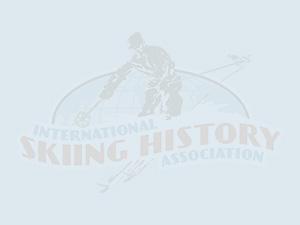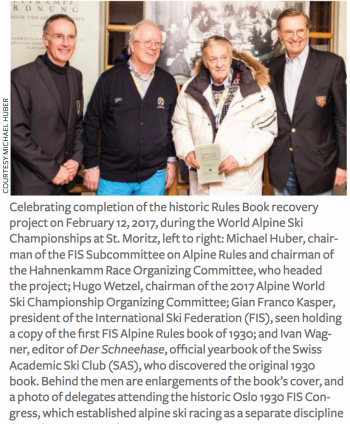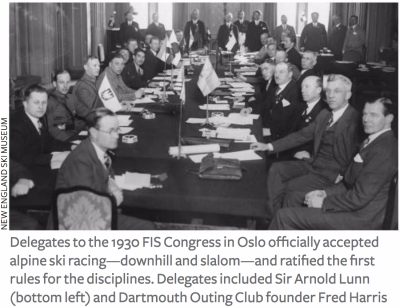
Special report: A six-year effort, led by FIS Alpine Rules chief Michael Huber, has yielded the first comprehensive digital collection of the changing rules that have governed ski racing over 80 years.
Alpine ski racing has a precise birth date. On February 26, 1930, in Oslo, Norway, the Congress of the International Ski Federation (FIS) officially accepted alpine ski racing—downhill and slalom—as a separate discipline. The FIS had previously recognized only the disciplines of competitive nordic skiing—cross-country and jumping.
Delegates to the 1930 Congress also adopted the first official rules for alpine racing. But what precisely were they? And where could they be found? Had no one kept a copy?
 For Michael Huber of Kitzbühel, Austria, chairman of the FIS Subcommittee on Alpine Rules and president of the famous Kitzbühel Ski Club (K.S.C.), the challenge was irresistible: to find the book. Huber would spend six years searching for it. And not only seeking the alpine competitions rules book of 1930, but also all official published FIS alpine rules of the past. Huber’s goals were:
For Michael Huber of Kitzbühel, Austria, chairman of the FIS Subcommittee on Alpine Rules and president of the famous Kitzbühel Ski Club (K.S.C.), the challenge was irresistible: to find the book. Huber would spend six years searching for it. And not only seeking the alpine competitions rules book of 1930, but also all official published FIS alpine rules of the past. Huber’s goals were:
- To make the alpine racing rules as they existed over an 85-year span available digitally for people around the world.
- To gain insight into the very early history of competitive alpine skiing.
- To understand why specific rules were written as they were, when and how they were changed, and to better identify what was the core of the sport that remained unchanged.
Huber asked officials, experts, organizations and museums for help. First, the International Skiing History Association (ISHA), through its magazine Skiing History and its Website skiinghistory.org, under the lead of John Fry, sent out an international call, asking people to submit copies of old Alpine Rules books. Well-known ski historian E. John B. Allen of New Hampshire soon reported that the New England Ski Museum in Franconia had a number of books from the 1930s into the 1980s, most in English, some in German. The New England Museum’s staff copied countless pages and sent them to Europe for processing.
“The Book is Found!”
Still, the most sought-after book, the original rules book of 1930, was missing.
Then it happened: Last year, Ivan Wagner, the editor of the Schneehase, the official publication of the Swiss Academic Ski Club (SAS), sent a note to Huber. “I think we’ve got it. It’s found!” After much searching, Schneehase’s former editor, Raoul Imseng, had discovered, in Issue No. 4 printed in 1931, the full and official German wording of the International Competition Rules for Slalom and Downhill Races, established at the XI International Ski Congress in Oslo and Finse (Norway), 1930.
Next step was to translate the German version into English. The long-serving member of the Subcommittee on Alpine Rules, the British native Martin John Leach, who has lived for many years in Switzerland, was ready to do the job.
 Flag Colors, Team Races
Flag Colors, Team Races
What is the content of the Alpine Rules of 1930? The 14 pages are divided into ten chapters. The first chapter deals with the organization and officials needed to run an alpine competition, like “the Setter” and the “Flag-keepers.” The second chapter deals with “Flags” for Downhill—originally red, blue and yellow.
Another section deals with the different types of start, like simultaneous start, individual start, team and slalom start. Surprisingly, the alpine combined is not of primary interest. (Surprising because the combined was the primary focus of the pre-existing famous Arlberg Kandahar of Hannes Schneider and Arnold Lunn.) Rather the rules focus on “Team Races in Downhill and Slalom.”
It didn’t take long for the original rules to undergo change. Only two years later, the alpine FIS Rules of 1932 defined the flag colors for slalom as two; penalized a competitor five seconds for making a false start; required racers to be more than 18 years of age; and prohibited a competitor from making more than one start unless handicapped by the presence on the course of a spectator or a dog.
The results go live online
The former chairman of the Subcommittee on Alpine Rules and predecessor president of the K.S.C., Christian Poley, added missing books of past years. So the digital archive now includes about 60 different Alpine Rules books from 1930–2016 in English, German and French.
To create digital access to all of the rules, the copied material had to be scanned and laid out—work done by the staff of the Kitzbühel Ski Club under Barbara Thaler. In a final step, Sarah Lewis, FIS Secretary General, provided a special place on the FIS website for digital storage, so the public worldwide can access more than eight decades of alpine ski racing rules. “Thanks to all who made this project a success,” says Huber.
To access the FIS Alpine Rules book digital archive, go to: http://www.fis-ski.com/inside-fis/document-library/alpine-skiing/#deepli....
